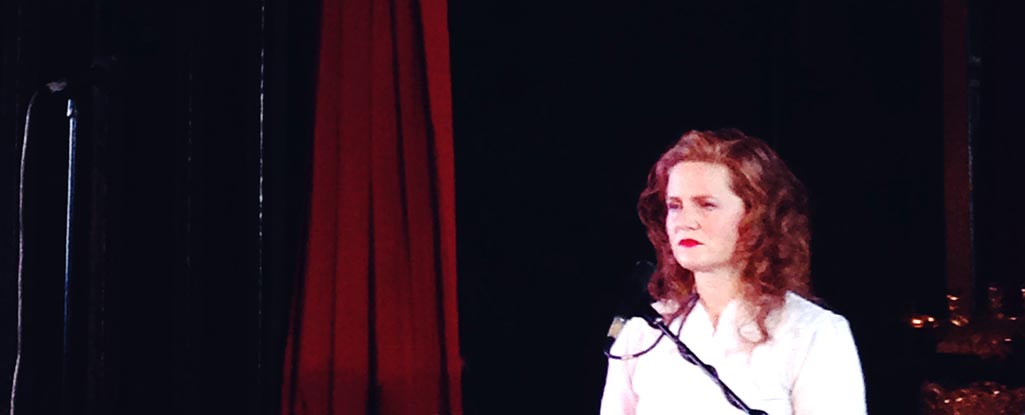Juliana Biondo reviews Stellar Cellar at the Charm City Fringe Festival
I was skeptical of what the Charm City Fringe Festival could offer that wouldn’t feel sophomoric. The word “Fringe” sounds problematic. If something is “fringe”, it resides on the outskirts, the unrecognized area. Would this non-recognition make the work different or just bad? Would the casual set designs and simple costumes feel apathetic? Would all of the characters be meta interpretations of everyday objects? It turned out my skepticism was completely misplaced. The theatre I saw was fresh, unforced, and hilarious. The environment was both comfortable and edgy. The festival attracted a diverse audience, from young to old, and theatre snob to theatre newbie.
The Charm City Fringe Festival is a convening of the underground theatre communities of Baltimore. The goal is to present works of art from actor collectives, and individual artists in order to engage their work with a wide array of “non-traditional” audiences. The Festival also seeks to provide varied experiences for those already dedicated theatregoers. As the Festival says, they hope to bring artists “out of the woodwork to do what they do best.” Baltimore’s Festival is in good company; Fringe Theatre festivals are an international trend, occurring from San Francisco to Edinburgh.
Stellar Cellar, created and performed by Temple Crocker, Dan Hanrahan, Christie Ferrera, Greg Romero, Sarah Lloyd, and Daniel Friedman, was a performance I saw at Church & Co. Dionysus, the God of Wine, started off their performance, or rather invoked it. A little wine never hurt anybody, right? There is a wine for every occasion, and often an occasion is not needed. One glass in and you are feeling good; two glasses in, you are feeling great. Three glasses in? That’s where things get interesting.
What happens when we “lose our train of thought”? What does that mean chemically is going on in our brain? Or, is it less a question of chemistry and more about the vast world of the subconscious? If we can drift so easily in and out of focus, maybe we are always delusional— thinking we can control what we think. Maybe there is something omnipresent in life that has more control than we realize. It is this idea of delusion and the questioning of the omnipresent, that Stella Cellar confronts.
A radio talk show about wine provided the main armature for the performance. The host walked us through four wines describing their full-bodied flavors, or wispy scents. Each one of her descriptions would gradually grow into a monologue of personal daydreams. The other actors would sporadically punctuate these daydreams with intrusions. These intrusions mimicked the commercial breaks present in any TV or radio show.
Stellar Cellar was surrealist in that it utilized dreams and illogical set-ups. Yet, unlike many surrealist works which are ad hoc and unconnected, Stellar Cellar remained in focus, revealed what the shared trigger for each of these seemingly unrelated ideas and situations was: mass media. By using the structure of a media talk show, the “talk” became discreetly unified to maintain randomness akin to the subconscious.
The directors were very intentional in how they wanted to invert the commercial media format. Actor Dan Hanrahan reflected after the show, “We live in a world where media is a common ground….we wanted to take (the performance) to a place that is unexpected. Rather than a tool for indoctrination you could use that same form to can opener someone up. Mainstream media can transcend into poetry.” Actor Chrsitine Ferrara agreed and chimed in, “Once the commercial edifice is cracked, all kinds of things can enter in.”
Stellar Cellar took a creative risk by pushing the boundaries of commercial edifice. As diversions from the wine “talk show” there were scenes involving mainly silent interactions between a fox and a bear. These segments slowed the pace of the performance to the point the viewer became fixated on just one thing—movement. The actors who played the fox and bear gestured at a glacier pace; the act of simply raising a leg would last almost a full minute. Eye contact, and physical closeness became the only means through which the audience could detect a narrative.
While these segments were successful in enriching the plays sense of mystery of the subconscious the audio stories were preferable. The audio stories added the final, most important layer to the work: a paradox. Through audio, the entire performance asked the audience to experience wine intoxication by listening to words. The fox and bear segments did not allow the audience to continue on with a intellectual attempt to experience something that is usually sensory. They detracted from the confrontational nature of the performances and its focus on how one’s mind warps and adjusts to mass communication. Instead, they brought us to a space of aimless confusion.
The Charm City Fringe Festival is something I hope will continue. Presenting many intertwined layers, Stellar Cellar is an example of the kind of performance that is highly intellectual and accessible. The performance space was haphazard with a vintage shop-like feel, but the artistry of the performance was intentional. Risks were taken, and questions were posited to bring the audience into the nexus of mass media and the subconscious. This combination provided a refreshing level of casual artistic ingenuity for anyone interested in the experience. This kind of artistic product is truly unique.
Juliana Biondo is a writer, artist, and historian of modern art.









